window Alfa Romeo 159 2006 Owner handbook (in English)
[x] Cancel search | Manufacturer: ALFA ROMEO, Model Year: 2006, Model line: 159, Model: Alfa Romeo 159 2006Pages: 299, PDF Size: 4.64 MB
Page 101 of 299

99
SAFETY
DEVICES
WARNING
LIGHTS AND
MESSAGES
IN AN
EMERGENCY
CAR
MAINTENANCE
TECHNICAL
SPECIFICATIONS
INDEX
CORRECT USE
OF THE CAR
DASHBOARD
AND
CONTROLS
In this case it is necessary to carry out
system restore procedure as follows:
❒open the windows;
or
❒remove and then refit the key into the
ignition device.
If no malfunction is present, the window
returns to its normal operation automat-
ically. In the event of a failure see section
“Warning lights and messages”.
Windows and sunroof
opening/closing by the
electronic key
(where provided)
By the metal insert of the key
On all versions:
❒turning clockwise the metal insert of
the key into the driver's door re-
volving plug will open all the win-
dows and the sunroof (where pro-
vided) at the same time.
❒turning counterclockwise the metal
insert of the key into the driver's
door revolving plug will close all the
windows and the sunroof (where
provided) at the same time.By remote control
On all versions, keep button
Ëpressed
for over 2 seconds to open all the win-
dows and the sunroof (where provided)
at the same time.
On versions provided with 4 power win-
dow, keep button
Ápressed for over 2
seconds to close all the windows and
the sunroof (where provided) at the
same time.
POWER WINDOWS
Versions with 2 front power windows
are fitted with automatic window open-
ing/closing only on the driver’s side.
Versions with 4 power windows are fit-
ted with automatic window opening/
closing on all doors. These versions are
fitted with anti-crushing safety device to
detect the presence of an obstacle in the
window closing stroke. If an obstacle
is detected, the safety system will stop
window closing and, according to win-
dow position, will also reverse window
stroke.
This system is particularly useful when
children operate the windows inadver-
tently and make it possible to
close/open the windows using the re-
mote control when leaving the car.
IMPORTANTIn the event the anti-
crushing function is activated 5 times in
only 1 minute or in the event of a fail-
ure, the system will automatically enter
the “recovery” mode (self-protection).
This condition is pointed out by the fact
that, in the closing stroke, the windows
goes up in jerks.
The system complies
with the forthcoming
Standard 2000/4/ EC
concerning the safety of pas-
sengers leaning out of the pas-
senger compartment.
Page 102 of 299

100
SAFETY
DEVICES
WARNING
LIGHTS AND
MESSAGES
IN AN
EMERGENCY
CAR
MAINTENANCE
TECHNICAL
SPECIFICATIONS
INDEX
CORRECT USE
OF THE CAR
DASHBOARD
AND
CONTROLS
C(where provided) – rear left window
opening/closing; “automatic continu-
ous” mode operation during window
opening/closing;
D(where provided) – rear right win-
dow opening/closing; “automatic con-
tinuous” mode operation just during win-
dow opening;
E(where provided) – rear power win-
dow enabling/disabling controls (when
rear power window controls are dis-
abled, the led on button Ewill turn on
and disabled controls will turn off).
Press buttons A,B,CorDto open/
close the required window.
Pressing briefly one of the buttons the
window “jerks” whereas a prolonged
pressing makes the window opening or
closing in “automatic continuous”
mode.
Pressing button A,B,CorDagain will
stop the window in the required posi-
tion.Front passenger door/
rear doors
Front passenger door and, on certain
versions, rear doors are fitted with but-
ton panels controlling opening/closing
of the corresponding window.
CONTROLS
Driver side
On the driver’s door panel are set the
buttonsfig. 93 for controlling, with
electronic key fitted into the ignition de-
vice:
A– front left window opening/closing;
window opening or closing in “auto-
matic continuous” mode;
B– front right window opening/clos-
ing; window opening or closing in “au-
tomatic continuous” mode (only ver-
sions with 4 power windows);
A0E0051mfig. 93
Improper use of the
power windows can be
dangerous. Before and
during its operation ensure that
any passengers are not at risk
from the moving glass either by
personal objects getting caught
in the mechanism or by being in-
jured by it directly. Always re-
move the ignition key when
getting out of the car to prevent
the power windows being op-
erated accidentally and consti-
tuting a danger to the passen-
gers in the car.
Page 131 of 299

129
WARNING
LIGHTS AND
MESSAGES
IN AN
EMERGENCY
CAR
MAINTENANCE
TECHNICAL
SPECIFICATIONS
INDEX
CORRECT USE
OF THE CAR
DASHBOARD
AND
CONTROLS
SAFETY
DEVICES
S S
A A
F F
E E
T T
Y Y
D D
E E
V V
I I
C C
E E
S S
SEAT BELTS ....................................................... 130
S.B.R. SYSTEM ................................................. 131
PRETENSIONERS ................................................ 132
CARRYING CHILDREN SAFELY ............................... 135
PRESETTING FOR MOUNTING THE
“UNIVERSAL ISOFIX”CHILD RESTRAINT SYSTEM..... 140
FRONT AIR BAGS................................................ 142
SIDE AIR BAGS (Side bag - Window bag) ............. 146
Page 148 of 299

146
WARNING
LIGHTS AND
MESSAGES
IN AN
EMERGENCY
CAR
MAINTENANCE
TECHNICAL
SPECIFICATIONS
INDEX
CORRECT USE
OF THE CAR
DASHBOARD
AND
CONTROLS
SAFETY
DEVICES
❒passenger's front air bag and knees
air bag (where provided) and side
bag deactivated (OFFposition
F):
warning light
Fon front ceiling light
panel on; it is possible to carry a child
protected by special restraint systems
on the front seat.
The warning light
Fon front ceiling
light panel stays on permanently until the
passenger’s air bags are reactivated.
Passenger's air bags deactivation will
not inhibit the operation of the head pro-
tection side bag (Window Bag).
SIDE AIR BAGS
(Side bag -
Window bag)
The car is fitted with front side bags for
driver and passenger for protecting the
chest and window bags for protecting front
and rear occupant’s head.
Side bags protect car occupants from
side crashes of medium-high severity, by
placing the cushion between the occu-
pant and the internal parts of the side
structure of the car.
Non-activation of side bags in other
types of collisions (front collisions, rear
shunts, roll-overs, etc...) is not a system
malfunction.In case of side crash, an electronic con-
trol unit, when required triggers the in-
flation of the cushion. The cushion im-
mediately inflates, placing itself as a pro-
tection, between the occupant’s body
and the structure that could cause in-
juries. Immediately after, the cushion de-
flates.
Side air bags are not a replacement of
but complementary to the belts, which
you are recommended to always wear,
as specified by law in Europe and most
non-European countries.
Page 149 of 299

147
WARNING
LIGHTS AND
MESSAGES
IN AN
EMERGENCY
CAR
MAINTENANCE
TECHNICAL
SPECIFICATIONS
INDEX
CORRECT USE
OF THE CAR
DASHBOARD
AND
CONTROLS
SAFETY
DEVICES
SIDE WINDOW BAGS -
HEAD PROTECTION
They are “curtain” cushions located be-
hind the side coverings of the roof fig.
20and covered by proper finishing.
Window bags have been designed for
protecting the head of front and rear oc-
cupants in the event of side crash,
thanks to the wide cushion inflation sur-
face.
In minor side crashes (for which the re-
straining action of the seat belts is suf-
ficient), the air bags are not deployed.Also in this case it is of vital importance
to wear the seat belts since in case of
side crash they guarantee proper posi-
tioning of the occupant and prevent the
occupants to be pitched out of the car in
case of violent crashes.
IMPORTANTIn the event of side
crash, you can obtain the best protec-
tion by the system keeping a correct po-
sition on the seat, allowing thus a cor-
rect window bag unfolding.
IMPORTANTThe front air bags
and/or side bags may be deployed if
the car is subject to heavy knocks or
accidents involving the underbody area,
such as for example violent shocks,
against steps, kerbs or low obstacles,
falling of the car in big holes or sags in
the road.
FRONT SIDE BAGS - CHEST
AND PELVIS ZONE
PROTECTION
They are composed by two types of in-
stant inflation cushions and are housed
in the back rest of the front seats fig.
19. The task of the side air bags is to
increase protection of the occupants’
chest and pelvis zone in the event of a
side crash of medium-high severity.
A0E0093mfig. 19A0E0185mfig. 20
Page 150 of 299
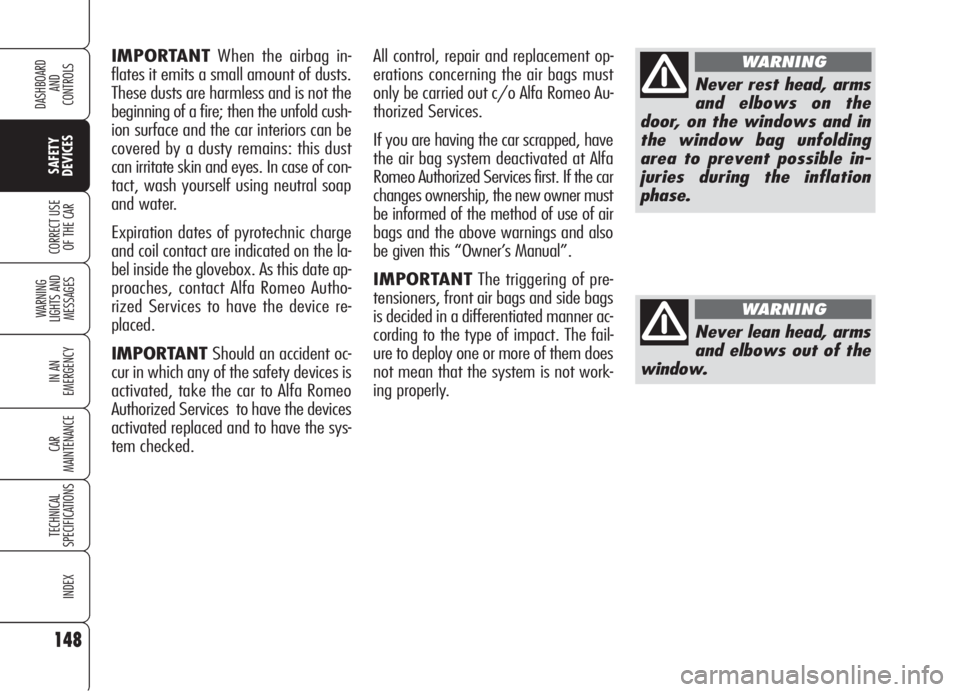
148
WARNING
LIGHTS AND
MESSAGES
IN AN
EMERGENCY
CAR
MAINTENANCE
TECHNICAL
SPECIFICATIONS
INDEX
CORRECT USE
OF THE CAR
DASHBOARD
AND
CONTROLS
SAFETY
DEVICES
IMPORTANTWhen the airbag in-
flates it emits a small amount of dusts.
These dusts are harmless and is not the
beginning of a fire; then the unfold cush-
ion surface and the car interiors can be
covered by a dusty remains: this dust
can irritate skin and eyes. In case of con-
tact, wash yourself using neutral soap
and water.
Expiration dates of pyrotechnic charge
and coil contact are indicated on the la-
bel inside the glovebox. As this date ap-
proaches, contact Alfa Romeo Autho-
rized Services to have the device re-
placed.
IMPORTANTShould an accident oc-
cur in which any of the safety devices is
activated, take the car to Alfa Romeo
Authorized Services to have the devices
activated replaced and to have the sys-
tem checked.All control, repair and replacement op-
erations concerning the air bags must
only be carried out c/o Alfa Romeo Au-
thorized Services.
If you are having the car scrapped, have
the air bag system deactivated at Alfa
Romeo Authorized Services first. If the car
changes ownership, the new owner must
be informed of the method of use of air
bags and the above warnings and also
be given this “Owner’s Manual”.
IMPORTANTThe triggering of pre-
tensioners, front air bags and side bags
is decided in a differentiated manner ac-
cording to the type of impact. The fail-
ure to deploy one or more of them does
not mean that the system is not work-
ing properly.
Never rest head, arms
and elbows on the
door, on the windows and in
the window bag unfolding
area to prevent possible in-
juries during the inflation
phase.
WARNING
Never lean head, arms
and elbows out of the
window.
WARNING
Page 159 of 299
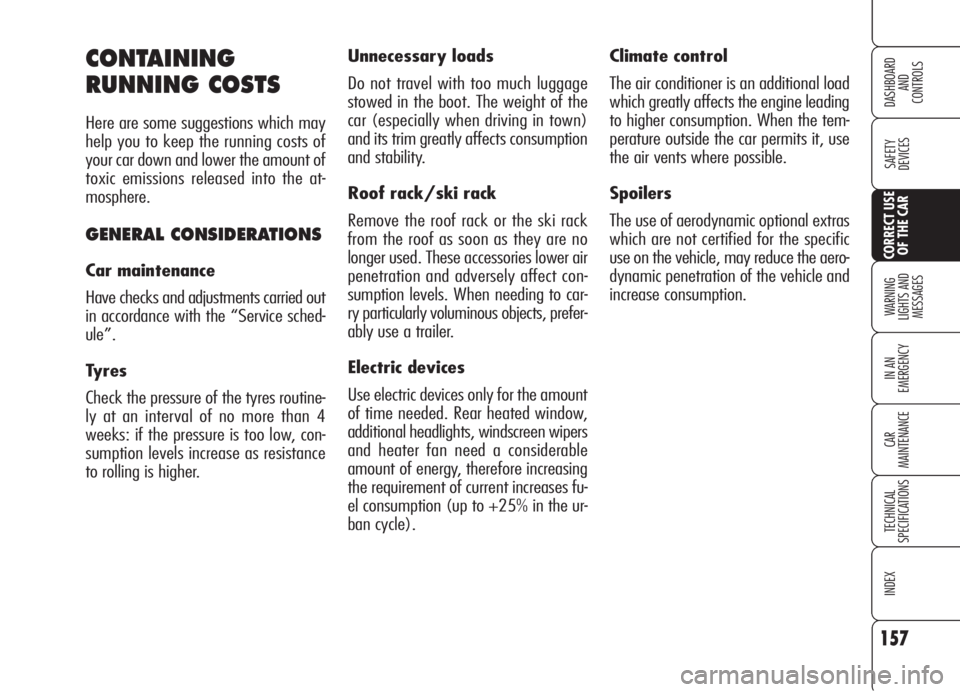
157
SAFETY
DEVICES
WARNING
LIGHTS AND
MESSAGES
IN AN
EMERGENCY
CAR
MAINTENANCE
TECHNICAL
SPECIFICATIONS
INDEX
DASHBOARD
AND
CONTROLS
CORRECT USE
OF THE CAR
Climate control
The air conditioner is an additional load
which greatly affects the engine leading
to higher consumption. When the tem-
perature outside the car permits it, use
the air vents where possible.
Spoilers
The use of aerodynamic optional extras
which are not certified for the specific
use on the vehicle, may reduce the aero-
dynamic penetration of the vehicle and
increase consumption. Unnecessary loads
Do not travel with too much luggage
stowed in the boot. The weight of the
car (especially when driving in town)
and its trim greatly affects consumption
and stability.
Roof rack/ski rack
Remove the roof rack or the ski rack
from the roof as soon as they are no
longer used. These accessories lower air
penetration and adversely affect con-
sumption levels. When needing to car-
ry particularly voluminous objects, prefer-
ably use a trailer.
Electric devices
Use electric devices only for the amount
of time needed. Rear heated window,
additional headlights, windscreen wipers
and heater fan need a considerable
amount of energy, therefore increasing
the requirement of current increases fu-
el consumption (up to +25% in the ur-
ban cycle).CONTAINING
RUNNING COSTS
Here are some suggestions which may
help you to keep the running costs of
your car down and lower the amount of
toxic emissions released into the at-
mosphere.
GENERAL CONSIDERATIONS
Car maintenance
Have checks and adjustments carried out
in accordance with the “Service sched-
ule”.
Tyres
Check the pressure of the tyres routine-
ly at an interval of no more than 4
weeks: if the pressure is too low, con-
sumption levels increase as resistance
to rolling is higher.
Page 166 of 299
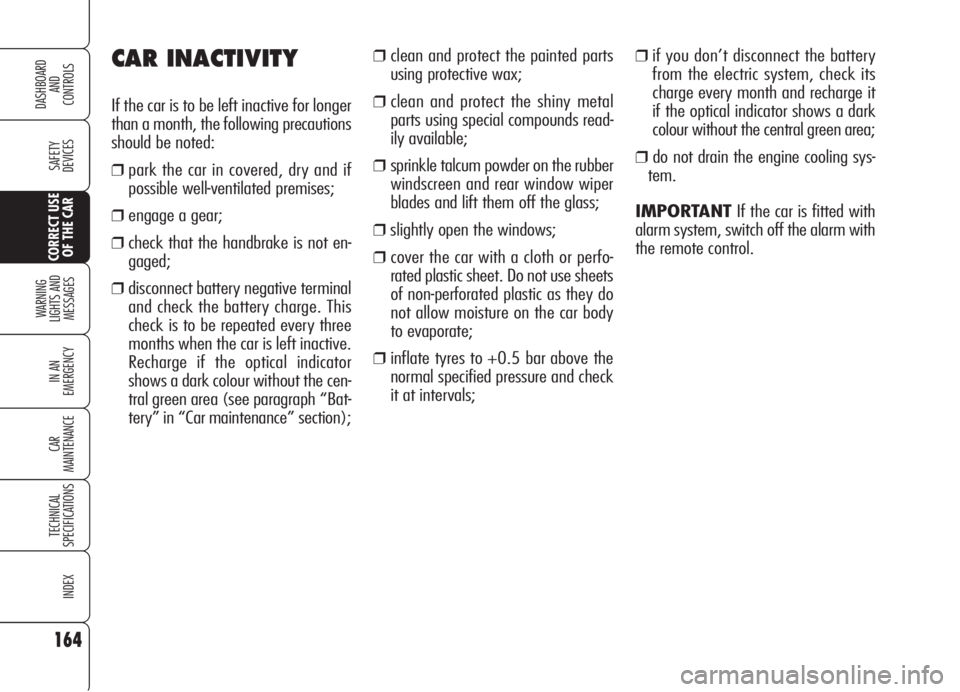
164
SAFETY
DEVICES
WARNING
LIGHTS AND
MESSAGES
IN AN
EMERGENCY
CAR
MAINTENANCE
TECHNICAL
SPECIFICATIONS
INDEX
DASHBOARD
AND
CONTROLS
CORRECT USE
OF THE CAR
CAR INACTIVITY
If the car is to be left inactive for longer
than a month, the following precautions
should be noted:
❒ park the car in covered, dry and if
possible well-ventilated premises;
❒ engage a gear;
❒check that the handbrake is not en-
gaged;
❒disconnect battery negative terminal
and check the battery charge. This
check is to be repeated every three
months when the car is left inactive.
Recharge if the optical indicator
shows a dark colour without the cen-
tral green area (see paragraph “Bat-
tery” in “Car maintenance” section);
❒clean and protect the painted parts
using protective wax;
❒clean and protect the shiny metal
parts using special compounds read-
ily available;
❒sprinkle talcum powder on the rubber
windscreen and rear window wiper
blades and lift them off the glass;
❒slightly open the windows;
❒cover the car with a cloth or perfo-
rated plastic sheet. Do not use sheets
of non-perforated plastic as they do
not allow moisture on the car body
to evaporate;
❒inflate tyres to +0.5 bar above the
normal specified pressure and check
it at intervals;
❒if you don’t disconnect the battery
from the electric system, check its
charge every month and recharge it
if the optical indicator shows a dark
colour without the central green area;
❒do not drain the engine cooling sys-
tem.
IMPORTANTIf the car is fitted with
alarm system, switch off the alarm with
the remote control.
Page 217 of 299
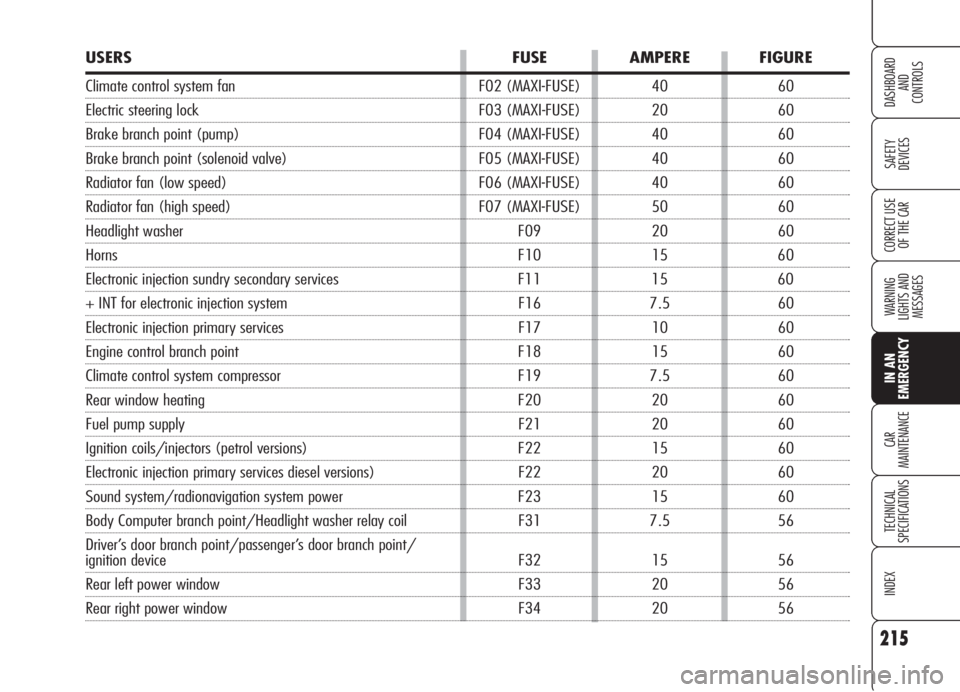
215
SAFETY
DEVICES
WARNING
LIGHTS AND
MESSAGES
CAR
MAINTENANCE
TECHNICAL
SPECIFICATIONS
INDEX
CORRECT USE
OF THE CAR
DASHBOARD
AND
CONTROLS
IN AN
EMERGENCY
USERS FUSE AMPERE FIGURE
Climate control system fan F02 (MAXI-FUSE) 40 60
Electric steering lock F03 (MAXI-FUSE) 20 60
Brake branch point (pump) F04 (MAXI-FUSE) 40 60
Brake branch point (solenoid valve) F05 (MAXI-FUSE) 40 60
Radiator fan (low speed) F06 (MAXI-FUSE) 40 60
Radiator fan (high speed) F07 (MAXI-FUSE) 50 60
Headlight washer F09 20 60
Horns F10 15 60
Electronic injection sundry secondary services F11 15 60
+ INT for electronic injection system F16 7.5 60
Electronic injection primary services F17 10 60
Engine control branch point F18 15 60
Climate control system compressor F19 7.5 60
Rear window heating F20 20 60
Fuel pump supply F21 20 60
Ignition coils/injectors (petrol versions) F22 15 60
Electronic injection primary services diesel versions) F22 20 60
Sound system/radionavigation system power F23 15 60
Body Computer branch point/Headlight washer relay coil F31 7.5 56
Driver’s door branch point/passenger’s door branch point/
ignition device F32 15 56
Rear left power window F33 20 56
Rear right power window F34 20 56
Page 218 of 299
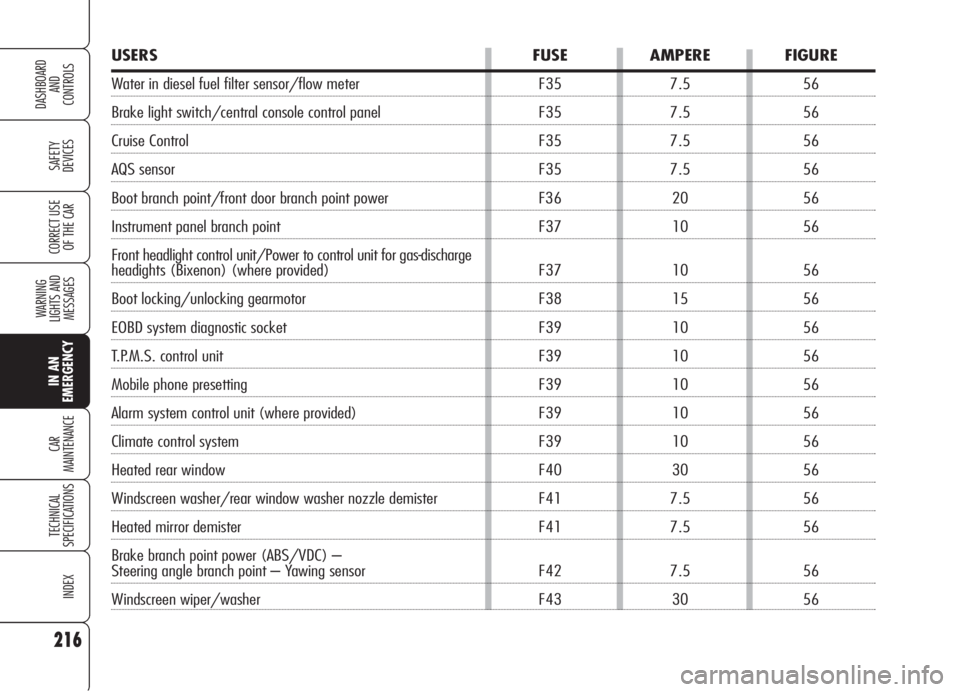
216
SAFETY
DEVICES
WARNING
LIGHTS AND
MESSAGES
CAR
MAINTENANCE
TECHNICAL
SPECIFICATIONS
INDEX
CORRECT USE
OF THE CAR
DASHBOARD
AND
CONTROLS
IN AN
EMERGENCY
USERS FUSE AMPERE FIGURE
Water in diesel fuel filter sensor/flow meter F35 7.5 56
Brake light switch/central console control panel F35 7.5 56
Cruise Control F35 7.5 56
AQS sensor F35 7.5 56
Boot branch point/front door branch point power F36 20 56
Instrument panel branch point F37 10 56
Front headlight control unit/Power to control unit for gas-discharge
headights (Bixenon) (where provided) F37 10 56
Boot locking/unlocking gearmotor F38 15 56
EOBD system diagnostic socket F39 10 56
T.P.M.S. control unit F39 10 56
Mobile phone presetting F39 10 56
Alarm system control unit (where provided) F39 10 56
Climate control system F39 10 56
Heated rear window F40 30 56
Windscreen washer/rear window washer nozzle demister F41 7.5 56
Heated mirror demister F41 7.5 56
Brake branch point power (ABS/VDC) –
Steering angle branch point – Yawing sensor F42 7.5 56
Windscreen wiper/washer F43 30 56